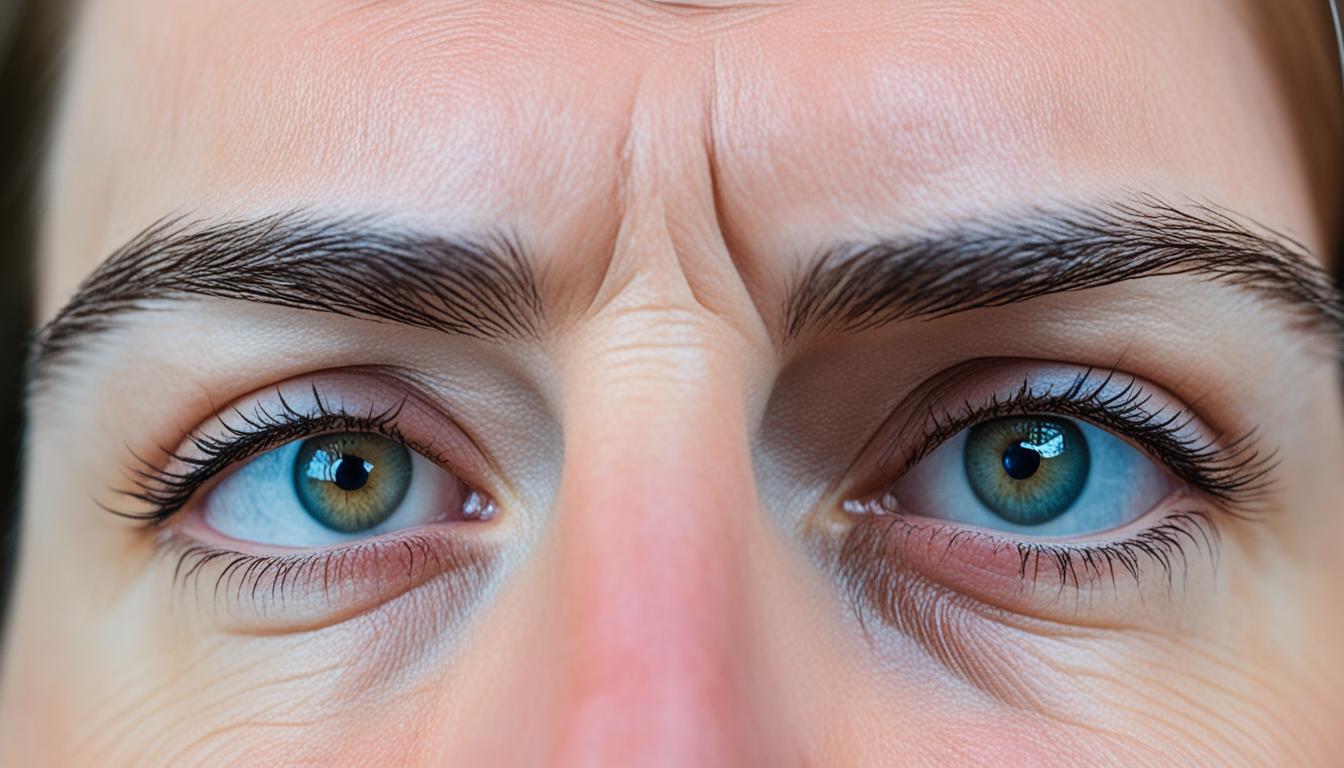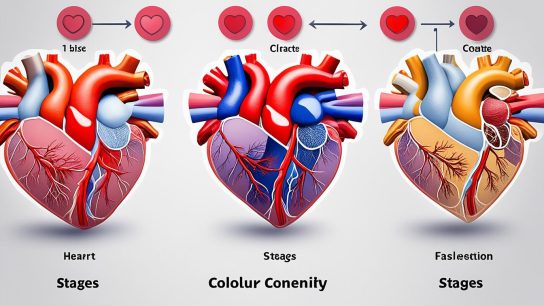Have you ever looked in the mirror and wondered why one of your eyes appears bigger than the other? Uneven eye appearance is a common concern that many individuals experience. Understanding the reasons behind different eye sizes can help alleviate any worries and provide insight into this natural occurrence.
There are several factors that can contribute to uneven eye appearance. Genetics, aging, and lifestyle choices can all play a role in determining the size and symmetry of our eyes. For some individuals, an underlying medical condition may be the cause.
Genetics and Uneven Eyes
When it comes to the size and appearance of our eyes, genetics play a significant role. If you find yourself with one eye bigger than the other, it’s possible that other members of your family share the same feature. However, it’s important to note that having asymmetrical eyes due to genetics is generally not a cause for concern.
Genetic factors can contribute to eye size discrepancy or eye size imbalance, resulting in an uneven appearance. While it may seem worrisome, it’s essential to understand that our bodies are unique, and slight variations in eye size or shape are normal.
To better appreciate the influence of genetics, here’s an example. Imagine your parents both have slightly different eye shapes or sizes. It is entirely likely that you may have inherited these traits, leading to the asymmetrical appearance.
To further illustrate the effect of genetics on eye size discrepancy, here is a table showcasing different eye characteristics within the same family:
| Family Member | Eye Size | Eye Shape |
|---|---|---|
| Grandfather | Bigger left eye | Almond-shaped |
| Mother | Bigger right eye | Round |
| Father | Balanced eyes | Round |
| You | Left eye slightly bigger | Almond-shaped |
As demonstrated in the table, genetic variations can lead to eye size discrepancies within a family. However, it’s important to remember that having asymmetrical eyes rooted in genetics is generally not a cause for concern. Embracing our unique features and understanding that these variations are a natural part of our genetic makeup can help promote self-acceptance and confidence.
Aging and Eye Size Discrepancy
As people age, the soft tissues in the face, including the eyes, can undergo changes. The relaxation of these tissues and the differential growth of cartilage and bones can lead to asymmetry. Imaging studies have shown a significant link between increasing age and facial asymmetry, including uneven eye size.
One of the main causes of uneven eye size in aging individuals is the loss of collagen and elastin, which are responsible for maintaining the elasticity and firmness of the skin. As these proteins decrease with age, the skin around the eyes may become looser and sag, resulting in an uneven appearance. Additionally, the natural aging process can cause a decrease in muscle tone, leading to a loss of support for the delicate structures surrounding the eyes.
Furthermore, the effects of aging on the eye sockets can also contribute to eye size asymmetry. Over time, changes in bone structure and density can occur, which may lead to variations in the shape and size of the eye sockets. This can result in one eye appearing larger or smaller than the other.
It is important to note that while aging is a common factor in eye size discrepancy, it is not the sole cause. Other factors such as genetics, lifestyle choices, and underlying medical conditions can also contribute to uneven eye appearance.
| Causes of Uneven Eye Size in Aging Individuals | Effects of Aging on Eye Appearance |
|---|---|
|
|
In conclusion, the aging process can contribute to eye size asymmetry, as the soft tissues and structures surrounding the eyes undergo changes over time. Understanding the effects of aging on eye appearance can help individuals recognize the natural variations in eye size and embrace facial asymmetry as a normal part of the aging process.
Lifestyle Factors and Uneven Eyes
While genetics and aging can play a significant role in the appearance of uneven eyes, certain lifestyle factors can also contribute to this asymmetry. Two common culprits are smoking and sun exposure.
Smoking and Droopy Eyelids
Research has shown a correlation between smoking and a condition known as upper eyelid ptosis, characterized by droopy eyelids. Smoking can weaken the connective tissues and muscles around the eyes, leading to sagging and asymmetry.
If you are a smoker and notice droopiness in your upper eyelids, quitting smoking may help prevent any further worsening of the condition. Additionally, consulting with a healthcare professional can provide guidance on available treatments to address the drooping eyelids.
Sun Exposure and Eye Asymmetry
Excessive sun exposure can have detrimental effects on the skin around the eyes, potentially causing asymmetry. The delicate skin in this area is more susceptible to damage from harmful UV rays, which can result in skin laxity, wrinkles, and uneven texture.
Protecting your eyes from the sun’s harmful rays is essential for maintaining eye health and preventing asymmetry. Wearing sunglasses with UV protection and using sunscreen around the eyes can help minimize the effects of sun exposure.
| Lifestyle Factors | Effects on Eye Symmetry |
|---|---|
| Smoking | – Increased risk of droopy eyelids – Weakening of connective tissues around the eyes |
| Sun Exposure | – Skin damage around the eyes – Increased appearance of wrinkles and uneven texture |
Underlying Medical Conditions and Asymmetrical Eyes
In addition to genetic factors, there are several medical conditions that can contribute to asymmetrical eyes. Understanding these conditions can help shed light on the potential causes of uneven eye appearance.
Bell’s Palsy and Eye Drooping
Bell’s palsy is a temporary facial paralysis that affects one side of the face, leading to drooping and weakness. As a result, the eye on the affected side may appear smaller or droopier than the other eye. While Bell’s palsy typically resolves on its own within a few weeks or months, its effects on facial symmetry can persist.
Trauma and Eye Damage
Eye trauma, such as injuries or accidents, can cause damage to the structures around the eye. This damage can lead to asymmetrical eyes, with the affected eye appearing different in size or shape compared to the other eye. Medical intervention may be required to address the underlying damage and restore balance.
Sinus Conditions and Enophthalmos
Sinus conditions, particularly chronic maxillary sinusitis or silent sinus syndrome, can contribute to enophthalmos, which is the sinking or retraction of the eyeball into the eye socket. Enophthalmos can result in an imbalance between the eyes, making one eye appear smaller or deeper-set than the other.
Graves’ Disease and Eye Bulging
Graves’ disease, an autoimmune disorder that affects the thyroid, can also impact the eyes. In some cases, it can cause eye bulging or proptosis, where the eye protrudes from the eye socket. This protrusion can lead to uneven eye appearance and contribute to facial asymmetry.
Stroke and Facial Asymmetry
A stroke, which occurs when blood flow to the brain is disrupted, can result in facial asymmetry, including the eyes. Depending on the location and severity of the stroke, one eye may appear smaller or droopier than the other. Rehabilitation and medical management are essential in restoring function and minimizing the impact on facial symmetry.
Understanding the underlying medical conditions that can contribute to asymmetrical eyes is crucial for appropriate diagnosis and treatment. If you notice significant asymmetry or changes in your eye appearance, it is essential to consult with a healthcare professional or an eye specialist for a thorough evaluation and personalized treatment plan.

| Medical Condition | Symptoms | Treatment |
|---|---|---|
| Bell’s Palsy | Drooping of one side of the face, affecting the eye | Typically resolves on its own, but may require medical intervention for symptom management |
| Trauma | Injury or accident leading to structural damage around the eye | Medical intervention to address the underlying damage |
| Sinus Conditions | Enophthalmos, sinking or retraction of the eyeball into the eye socket | Treatment of the sinus condition to alleviate enophthalmos |
| Graves’ Disease | Eye bulging or proptosis | Management of the underlying autoimmune disorder and potential surgical intervention |
| Stroke | Facial asymmetry, including uneven eye appearance | Rehabilitation and medical management for stroke recovery |
Treatment Options for Asymmetrical Eyes
In most cases, asymmetrical eyes do not require treatment. However, if an underlying medical condition is causing the asymmetry or if it is affecting vision, treatment options may be necessary. Treatment can include addressing the underlying medical condition, using Botox injections to achieve symmetry, undergoing a brow lift or blepharoplasty for eyelid correction, or even orbital surgery in certain cases.
Addressing Underlying Medical Conditions
If an underlying medical condition is identified as the cause of asymmetrical eyes, it is essential to address and manage that condition. This may involve medical intervention, such as medications, therapies, or surgical procedures. By treating the underlying condition, it is possible to achieve improved eye symmetry.
Botox for Eye Asymmetry
Botox, a popular cosmetic treatment, can also be used to address asymmetrical eyes. By injecting Botox into specific muscles around the eye, it can temporarily relax and soften the appearance of the eye area, creating a more balanced look. Botox can be a viable option for individuals who desire a non-surgical approach to correct uneven eyes.
Brow Lift for Eyelid Symmetry
A brow lift is a surgical procedure that aims to raise the brow and improve eyelid symmetry. By repositioning the brow and removing excess skin and fat, a brow lift can create a more harmonious appearance between the eyes. This procedure can be particularly beneficial for individuals with asymmetrical eyebrows or sagging eyelids.
Blepharoplasty for Uneven Eyelids
Blepharoplasty, also known as eyelid surgery, is another option to address uneven eyes. This procedure involves removing excess skin, fat, or muscle from the upper and/or lower eyelids, resulting in a more balanced look. Blepharoplasty can be performed for both cosmetic and functional reasons, improving both the appearance and function of the eyes.
Orbital Surgery for Eye Socket Issues
In cases where the asymmetry is due to underlying structural issues in the eye socket, orbital surgery may be necessary. This type of surgery focuses on correcting deformities or injuries to the eye socket, ensuring proper alignment and positioning of the eye. Orbital surgery can help restore symmetry and improve overall eye appearance.

Home Remedies and Cosmetic Solutions for Uneven Eyes
For those who wish to address uneven eyes for cosmetic reasons, there are several options available. Makeup techniques and eyelid tape are popular choices to achieve a more symmetrical appearance.
Makeup Techniques for Eye Symmetry
Makeup can be a powerful tool for creating the illusion of symmetry and balance. By understanding the shape and features of your eyes, you can use various techniques to enhance their appearance. Here are some makeup tips to help you achieve eye symmetry:
- Contouring: Use a matte eyeshadow slightly darker than your skin tone to create depth and dimension. Apply it to the crease of your smaller eye to make it appear larger.
- Highlighting: Apply a shimmery eyeshadow or highlighter to the inner corner of your smaller eye to brighten and open up the area.
- Eyeliner: Line both upper and lower lash lines with a dark eyeliner to define your eyes. Make sure to create a slightly thicker line on the smaller eye to make it appear bigger.
- Mascara: Apply multiple coats of mascara to both upper and lower lashes to add volume and length. This will help create a more balanced look.
Incorporating these makeup techniques into your routine can help create the appearance of symmetrical eyes, even if there is a slight size difference.
Eyelid Tape for Lifting Sagging Eyelids
Eyelid tape is a popular solution for lifting sagging eyelids and creating a more youthful and symmetrical eye appearance. This thin, transparent adhesive tape is carefully applied to the upper eyelid to lift and support the skin.
Here is a step-by-step guide on using eyelid tape:
- Cleanse and dry your eyelids to ensure they are free from oil and debris.
- Cut a desired length of eyelid tape that matches the length of your eyelid.
- Gently close your eye and apply the tape along the natural crease of your eyelid, starting from the inner corner and extending towards the outer corner.
- Press the tape down gently to secure it in place.
- Repeat the process on the other eye, making sure to align the tape symmetrically.
Eyelid tape can instantly lift sagging eyelids, creating the illusion of a more balanced eye shape. It is a temporary and non-invasive solution that can be easily removed at the end of the day.
Remember, while makeup techniques and eyelid tape can help improve the appearance of uneven eyes, it is important to embrace and celebrate your natural features. Beauty comes in all shapes and sizes, and our unique characteristics make us who we are.
Conclusion
Eye irregularity and size variation are common and natural occurrences that most people have to some degree. Embracing facial asymmetry is important as research suggests that a certain level of asymmetry is actually desirable. In fact, it’s often difficult for others to notice facial asymmetry in individuals.
For those who are concerned about uneven eyes, there are a range of options available. Consulting with an experienced eye doctor or healthcare professional is crucial to determine the underlying cause of the asymmetry and to explore the most appropriate course of action.
In many cases, asymmetrical eyes do not require treatment. However, if the unevenness is affecting your vision or is a result of an underlying medical condition, various medical treatments may be recommended. Additionally, cosmetic solutions such as makeup techniques, including contouring and highlighting, or the use of eyelid tape, can also help achieve a more symmetrical appearance.
Ultimately, it is important to remember that facial asymmetry is normal and accepting and embracing your unique features can help boost self-confidence and promote self-acceptance.




